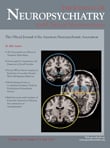SIR: It is well known that frontotemporal lobar degeneration (FTLD) is characterized by marked changes in behavior and personality. Although anxiety is identified in 39% of FTLD subjects, agitation,irritability and depression may also be observed.
1 Compulsive behaviors like OCD symptoms have also frequently been reported as early symptoms.
2 These compulsive behaviors are not associated with overt anxiety that is observed in OCD subjects. However, in the early stages of the FTLD, the symptoms of anxiety may not always distinguish typical anxiety disorder subjects from those suffering from a primary psychiatric disorder. Here, we report a case of FTLD who presented with panic attack as the first symptom. To the best of our knowledge, this is the first case of FTLD manifesting panic attack as the first symptom.
Case Report
A 48–year-old married, right-handed woman with 20 years of formal education first experienced a panic attack in April 1997, at the age of 44 years. She had no previous history of psychiatric disease. Her first panic attack occurred when she was going home in the subway from the hospital where her husband’s sister was hospitalized with a diagnosis of lung tumor. The panic attack was characterized by the sudden onset of symptoms such as palpitations, trembling, sensation of shortness of breath, and a feeling of choking, etc., which reached a peak within 10 minutes. During the next 1 month, she suffered from recurrent unexpected panic attacks several times a day in subways or buses, that is, in situations from which escape would have been difficult. In September 1997, she was admitted to the hospital for examination. At admission, she had no abnormal clinical neurological signs. She was therefore diagnosed as a case of panic disorder with agoraphobia. During the next few months, her panic attacks reduced in frequency despite her not having been prescribed any benzodiazepines or other psychotropic medication. In 1998, she gradually started showing diminished interest in her daily activities .In 2001, at the age of 48, her behavior and personality began to show gross changes. She sometimes jogged inappropriately and hugged unfamiliar people, and sang the same TV CM song repeatedly. She began to often exhibit imitation behavior, imitating medical staff’s sign or OK signs repeatedly. In addition, she started showing stereotypic and ritualistic behaviors, such as going to the same restaurant at a certain time. She lost insight into her behavioral and personality changes. MRI showed bilateral frontal lobe atrophy. No other abnormal findings could be detected on MRI. Brain ECD-SPECT showed hypoperfusion in the frontal lobes. Her neuropsychological assessment, including that of memory, language, and attention and executive functions, could not be completed because of both perseverative behavior and lack of interest. However, her episodic and semantic memory and visuospatial ability were relatively well preserved.
Comment
This case presented with a panic attack as a symptom of the initial phase of FTLD. Her behavior and personality gradually changed after the appearance of the panic attacks. Her previous medical and psychiatric history were unremarkable. Thus, it is likely that the patient’s first symptom of panic attack at the age of 44 years was a symptom of early stage FTLD. Both substance use and underlying systemic disease were ruled out as the cause of the panic attacks. The patient in the initial phase fulfilled the DSM-IV diagnostic criteria for panic disorder without agoraphobia.
The progressive behavioral and personality changes observed in this case, such as loss of insight and decline in social interpersonal conduct, impairments in the regulation of personal conduct, perseveration, stereotypic behavior, and disinhibition, were consistent with the clinical features of FTLD as defined by Neary et al.
3 Both the findings of frontal lobe atrophy on MRI and frontal lobe hypoperfusion on ECD-SPECT supported the diagnosis of FTLD. On the other hand, episodic and semantic memory, perception, and spatial skills were all well preserved. Therefore, the patient was diagnosed as a case of the frontal variant of frontotemporal dementia (fv-FTD).
Various behavioral symptoms have been reported as the first symptoms of FTLD. Compulsive behaviors and dietary changes are often observed in the initial stage of FTLD.
2 A recent study indicated that euphoria and aberrant motor activity, and disinhibition are prominent clinical features of FTLD.
4 Thus, to the best of our knowledge, panic attack has never yet been reported as a first symptom in cases of FTLD.
A neuroanatomical hypothesis has suggested that panic disorder may result from the dysfunction of a fear network in the brain located in the center of the amygdala. A recent neuroimaging study
5 indicated that subjects with panic disorder have a smaller volume of the amygdala as compared with normal healthy subjects. Even in the early stage of FTLD, not only frontal lobe but also atrophy of the amygdala has been shown by quantitative structural neuroimaging.
6 Therefore, it is likely that dysfunction of the amygdala might be associated with the panic attack in this case.
In conclusion, we must carefully observe the course of subjects with panic disorder, especially if the subjects have associated symptoms of apathy, disinbition and stereotypic behaviors. Further study may be expected to lend support to our contention in this case.

